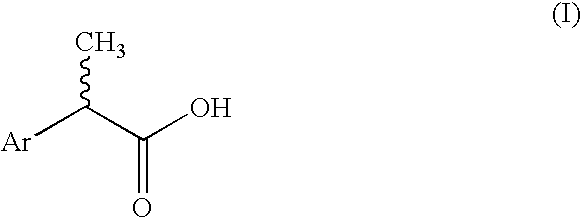2-Aryl-propionic acids and pharmaceutical compositions containing them
a technology of arylpropionic acid and pharmaceutical composition, which is applied in the direction of drug composition, cardiovascular disorder, respiratory disorder, etc., can solve the problems of severe limit to the therapeutic application of these compounds and the limitation of the use of these compounds in the therapy of il-8-mediated pathologies, and achieve the effect of preventing and preventing
- Summary
- Abstract
- Description
- Claims
- Application Information
AI Technical Summary
Benefits of technology
Problems solved by technology
Method used
Image
Examples
example 1
2-[3′-(isopropenyl)phenyl]propionic acid
The acid was synthesized starting from ethyl 3′-perfluorobutansulfonyloxy-2-phenylpropionate (7.63 mmol) that was dissolved in N-ethylpirrolidone (30 ml); to the mixture is added anhydrous LiCl (0.94 g, 22.9 mmol), triphenylarsine (90 mg; 0.3 mmol) and dipalladiumtribenzylidenacetone (0.173 g; 0.15 mmol Pd). After 5′ at r.t. tributylisopropenyltin (2.83 g; 8.55 mmol) is added and the solution is stirred for 5 h at T=90° C. After cooling the solution to r.t., the mixture is diluted with hexane and a saturated solution of KF is added; after filtration and separation of the phases the organic phase is dried over Na2SO4 and evaporated under vacuum. The purification of the residue by means of flash chromatography gives 2-[3′-isopropenylphenyl]ethyl propionate. (Ritter K., Synthesis, 735, 1993 and Mitchell T. N., Synthesis, 803, 1992).
1N NaOH (5 ml) was added to a solution of the ester in dioxan (5 ml) and the solution is stirred at r.t. overni...
example 2
2-[3′-(alpha-ethyl-propenyl)phenyl]propionic acid
According to the method reported above, the acid was synthesized by using as starting reagent tributyl-(α-ethyl)propenyl tin synthesized according to known methods (Ritter K., Synthesis, 735, 1993 and Mitchell T. N., Synthesis, 803, 1992).
1H-NMR (CDCl3): δ 10.0 (bs, 1H, COOH); 7.28 (m, 1H); 7.15 (m, 1H); 7.05 (m, 2H); 5.5 (m, 1H); 3.75 (m, 1H); 1.8-1.6 (q, 2H); 1.45 (d, 3H, J=7 Hz); 0.85 (d, 3H, J=7 Hz); 0.78 (t, 3H, J=7 Hz)
example 3
3-[3′-(1″-styrenyl)phenyl]propionic acid
According to the method reported above, the acid was synthesized by using as starting reagent tributyl-α-styrenyl tin synthesized according to known methods (Ritter K., Synthesis, 735, 1993 and Mitchell T. N., Synthesis, 803, 1992).
1H-NMR (CDCl3): δ 11.0 (bs, 1H, COOH); 7.38-7.13 (m, 9H); 3.95 (m, 2H); 3.81 (m, 1H); 1.72 (d, 3H, J=7 Hz).
PUM
| Property | Measurement | Unit |
|---|---|---|
| concentration | aaaaa | aaaaa |
| enantiomers | aaaaa | aaaaa |
Abstract
Description
Claims
Application Information
 Login to View More
Login to View More - R&D
- Intellectual Property
- Life Sciences
- Materials
- Tech Scout
- Unparalleled Data Quality
- Higher Quality Content
- 60% Fewer Hallucinations
Browse by: Latest US Patents, China's latest patents, Technical Efficacy Thesaurus, Application Domain, Technology Topic, Popular Technical Reports.
© 2025 PatSnap. All rights reserved.Legal|Privacy policy|Modern Slavery Act Transparency Statement|Sitemap|About US| Contact US: help@patsnap.com



